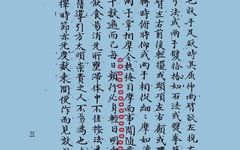In addition to eye exercises, what other daoyin (导引) techniques can protect the eyes?
(1) Source of Literature
This research primarily involved searching the “Complete Catalog of Ancient Chinese Medical Texts” for sections on health preservation, daoyin qigong (导引气功), and other related texts discovered during the study (all published before 1911, including that year).
(2) Source of Books
The main sources include data from libraries such as the Republic of China Medical Collection and electronic resources like Duxiu. (For information on how to access these electronic resources, please refer to previous posts on our public account!)
(3) Detailed Content
This article mainly introduces some scattered daoyin techniques.
From the Southern and Northern Dynasties to the Sui and Tang Dynasties, it was a time of convergence for Confucianism, Buddhism, and Daoism (also known as the “Three Teachings”), which significantly influenced medicine. This influence is specifically reflected in texts such as the “Treatise on the Origins and Symptoms of Diseases” (《诸病源候论》), which compiles the medical achievements of Confucianism, Buddhism, and Daoism into one volume; particularly, the “Treatise on the Origins and Symptoms of Diseases” does not record prescriptions but rather focuses on health preservation methods and daoyin techniques, making it quite distinctive. Compiled by Chao Yuanfang (巢元方) during the Sui Dynasty, the “Treatise on the Origins and Symptoms of Diseases” gathers daoyin techniques from before the Sui Dynasty, inheriting and developing the Chinese daoyin art from the Warring States to the Qin and Han Dynasties. This text records 38 common eye diseases, including symptoms such as mu feng lei chu (目风泪出候), mu an bu ming (目暗不明候), and mu mang mang (目茫茫候), which specifically detail corresponding health preservation methods and daoyin techniques, often involving body adjustments combined with breath regulation. The four scattered techniques in the mu feng lei chu category have the effect of dispelling wind evil, consistent with the original text’s description of the pathogenic mechanism: “wind evil injures the liver, and liver qi is insufficient,” reflecting the TCM principle of syndrome differentiation and treatment. In addition to eye diseases, daoyin techniques recorded for other conditions such as head and facial wind, dizziness from wind, wind deficiency fatigue, nasal polyps, and deafness also contribute to the prevention and treatment of eye diseases.
The “Essential Record for Health Preservation” (《保生要录》) by Pu Chuguan (蒲处贯) from the Song Dynasty lists a series of scattered techniques in the section on adjusting the body, including movements for the hands, feet, arms, head, neck, and waist. “Frequent practice daily will ensure a light body, clear vision, smooth blood circulation, easy digestion, and no stagnation in the body.”
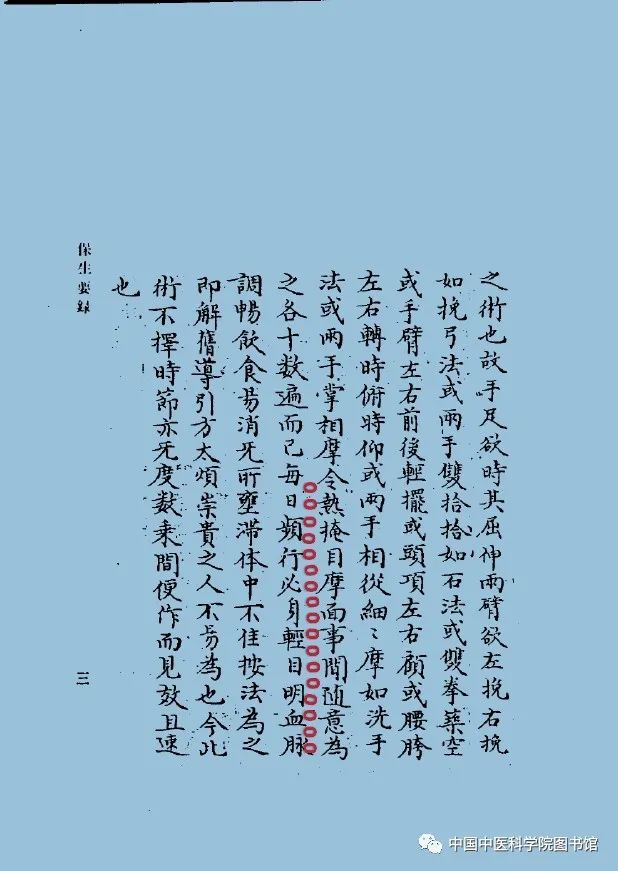
The authorship and era of the “Ta Qing Daoyin Health Preservation Classic” (《太清导引养生经》) are unclear. Some scholars believe that since it is neither recorded nor referenced in the “Book of Sui” (《隋书·经籍志》) or in Chao Yuanfang’s “Treatise on the Origins and Symptoms of Diseases,” it is likely that this text was compiled during the mid to early Tang Dynasty, as Daoist internal alchemy began to flourish around that time. Furthermore, it is believed that the “Ta Qing Daoyin Health Preservation Classic,” as the existing Daoist daoyin classic, not only stands out in Daoist daoyin methods but also holds a significant position in the history of the development of ancient Chinese daoyin techniques. This book contains numerous passages related to the prevention and treatment of eye diseases, such as five methods in the health preservation techniques of Master Ning, one method in the Pengzu Valley Immortal’s lying down technique, and two methods in the Wang Ziqiao’s Eight Deities daoyin technique, most of which are consistent with the content in the “Treatise on the Origins and Symptoms of Diseases.” For example, the action of grasping the neck pulse is described in Master Ning’s health preservation method as “lying down, pulling three times, using the hand to pinch the neck pulse three times, which makes the eyes clear.” In the Pengzu daoyin illustration, it is described as “…using the hands to cover both ears, pinching both pulse edges five times, which makes the eyes clear, and the eyes black and not white, treating head wind.” In the “Treatise on the Origins and Symptoms of Diseases,” it is described as “Also, lying down, pulling three times, using the hand to grasp the neck pulse five times, which makes the eyes clear. Lying flat, with the head slightly elevated, pulling three times, using both hands to pinch the neck pulse five times. This alleviates dark vision. After a long time, it allows the eyes to see colors at night. If practiced continuously, one can see in all directions without limits.”
The “Ancient Immortal’s Daoyin Massage Method” (《古仙导引按摩法》) found in the “Essence of Daoist Canon” (《道藏精华录》) has similarities with the content of the “Nourishing Life and Extending Life Record” (《养性延命录》) by Tao Hongjing (陶弘景) and the “Ta Qing Daoyin Health Preservation Classic.” The methods for improving vision are largely consistent with the content of the previous two texts, such as the daoyin methods described in the fifth section of the “Nourishing Life and Extending Life Record.”
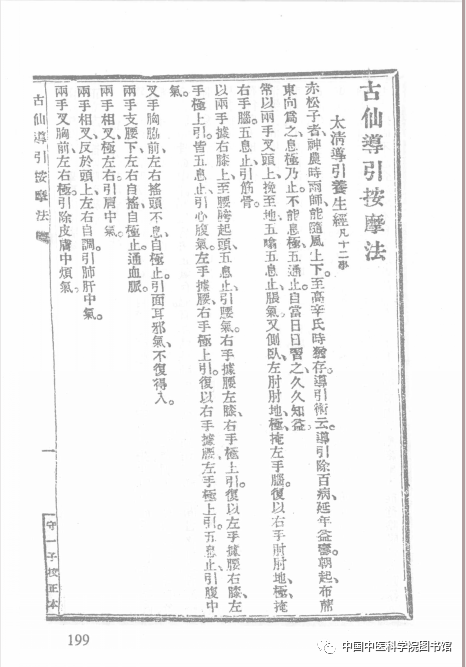
The “True Secrets of Health Preservation” (《卫生真诀》) by Luo Hongxian (罗洪先) from the Ming Dynasty records 49 daoyin methods with clear therapeutic scopes, covering over thirty diseases, three of which are related to eye conditions. The “Zhang Guolao’s Fire Adding Method” treats the three burners’ blood heat, which causes dim vision. The method is described as sitting upright, warming the navel with the hands, then pressing the knees, closing the mouth, sitting quietly, waiting for the breath to stabilize, and circulating the breath nine times. The “Pengzu’s Vision Improvement Method” is consistent with the description in the “Treatise on the Origins and Symptoms of Diseases,” involving extending the left leg, bending the right knee, pressing the left leg while applying pressure to the eyes at dawn. The “Cao Xiangu’s Tai Chi Observation Method” treats swollen and painful eyes through a combination of body movements and breath regulation.
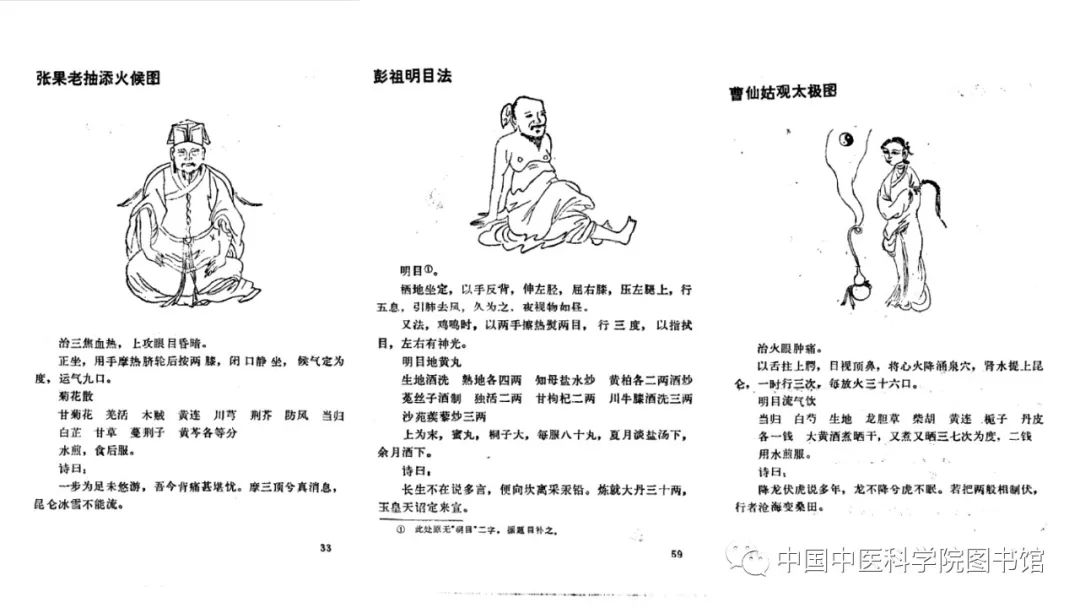
Eye exercises can enhance vision and improve eyesight. The Ming Dynasty’s Gong Juzhong (龚居中) in “Phlegm Fire Pointing Snow” mentions: “Rotate both eyes twelve times, tightly close them, then open wide, and breathe deeply five to seven times each night; the fog and haze will disperse, and brightness will return to normal.” The Qing Dynasty’s Ma Qi (马齐) in “Land Immortal Classic” and Sha Boqiang (邵博强) in “No-Medicine Treatment Method” also mention the function of eye exercises in removing eye haze and improving vision.
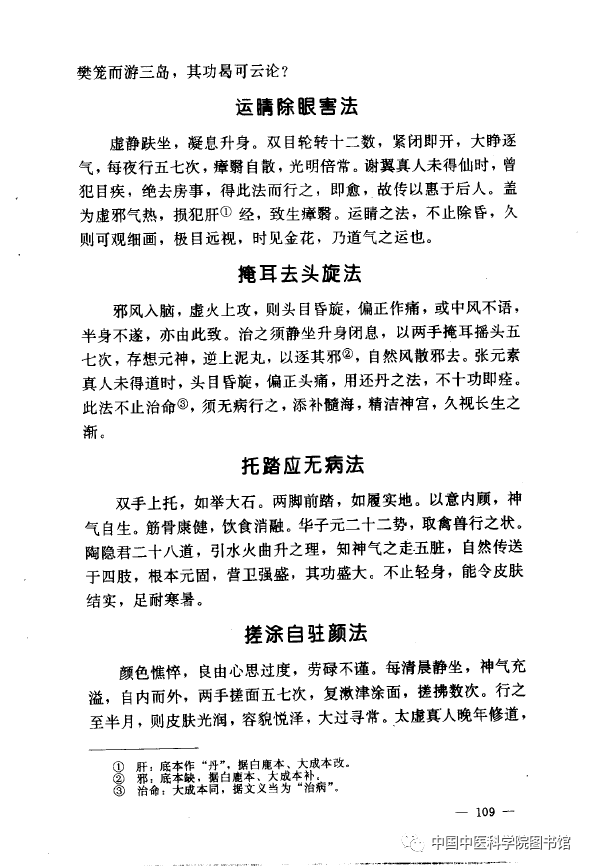
The Qing Dynasty’s Xu Wenbi (徐文弼) in “Longevity Truth” mentions that “crossing both hands behind the neck and looking up causes the hands and neck to exert force” has the effect of alleviating dim vision.
References:
[1]Wu Jinpeng. Research on the Meridian Theory of TCM Daoyin Techniques[D]. Beijing University of Chinese Medicine, 2007:8-9.
[2] Four Classics of TCM[M]. Fu Jinghua, Editor. Beijing: Ancient Chinese Medicine Publishing House, 1996.12.
[3] Ding Guangdi. Research on the Health Preservation Methods in the Treatise on the Origins and Symptoms of Diseases[M]. Beijing: People’s Health Publishing House, 2010: 1.
[4] Chao Yuanfang. Clinical Classics of TCM Intangible Cultural Heritage“Treatise on the Origins and Symptoms of Diseases”[M]. Beijing: China Medical Science and Technology Press, 2011:92+153-154.
[5] Pu Chuguan. Essential Record for Health Preservation[M]. Beijing: Zhonghua Book Company, 1991:3.
[6] Wei Yanli. Historical Research on Daoist Daoyin Techniques[D]. Shandong University, 2007:43+69.
[7] Ta Qing Daoyin Health Preservation Classic and Nourishing Life and Extending Life Record[M]. Ding Guangdi,Editor. Beijing: China Traditional Chinese Medicine Publishing House, 1993:4+38+97.
[8] Ding Fubao, Editor. Essence of Daoist Canon 2[M]. Beijing: Beijing Library Press, 2005:199-214.
[9] Luo Hongxian. True Secrets of Health Preservation[M]. Beijing: Ancient Chinese Medicine Publishing House, 1987:33+44+59.
[10] Gong Juzhong. Phlegm Fire Pointing Snow[M]. Fu Guozhi, Wang Qingwen,Editor. Beijing: People’s Health Publishing House, 1996:109.
[11] Ma Qi. Land Immortal Classic with Heart Medicine Collection, Verification of Xun Kunlun, and Secrets of Health Preservation[M]. Wang Yajun,Editor. Beijing: Ancient Chinese Medicine Publishing House, 1988:66+70+119+127.
[12]Sha Boqiang. Absolute Secrets of Kidney Nourishment[M]. Taiyuan: Shanxi Science and Technology Press, 2011:12.
[13]Xu Wenbi. Longevity Truth[M]. Wu Linpeng, Editor. Beijing: Ancient Chinese Medicine Publishing House, 1986:3-4+15.
Official WeChat Platform of the Library of the Chinese Academy of Traditional Chinese Medicine
Is your convenient secretary for library services
Is your mobile platform for TCM information
Keep in touch with the library anytime, anywhere
WeChat ID:cacms_library
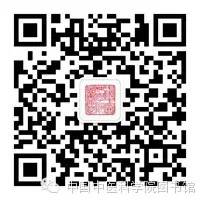
Long press the above imageto recognize the QR codeto follow us
If you like it, please give a thumbs up or click to view
Set the public account as a star mark so you won’t miss any messages!
If you have any specific literature needs, feel free to leave a message to contact us.

